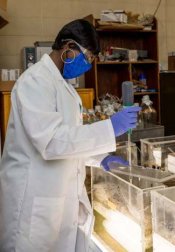Algae pull nutrients from swine facility manure, air
Swine manure is a rich source of nutrients, but its high phosphorus content in comparison to the other nutrients the crop needs means only so much can be spread on a field.

PI's:
Gary Anderson, Department of Agricultural and Biosystems Engineering
Xufei Yang, Department of Agricultural and Biosystems Engineering
Kyungnan Min, Department of Civil and Environmental Engineering
Students:
Doctoral student Augustina Osabutey
Read the Algae pull nutrients from swine facility manure, air news story
SDSU study examines woodchip quality in bioreactors
Draining excess water from fields is good for agricultural production, but the nutrient-laden water flowing through the drainage tile can pollute nearby water bodies. Diverting the water through an underground chamber filled with wood chips, known as a woodchip bioreactor, can help remove nitrates and thereby reduce the environmental impact on creeks, streams and lakes.

PI's:
Guanghui Hua, Department of Civil and Environmental Engineering
Chris Schmit, Department of Civil and Environmental Engineering
Kyungnan Min, Department of Civil and Environmental Engineering
Students:
Doctoral student Abdoul Aziz Kouanda
Read the SDSU study examines woodchip quality in bioreactors news story
Nonprofit joins battle to mitigate Lake Mitchell algal blooms
Lake Mitchell has a long history of algal blooms. The reservoir, built in 1928, was once a source of drinking water for the city of Mitchell and recreation for the community. However, by the 1990s, algal blooms increased due to nutrients accumulating in the lake. By 2003, the city stopped using the lake as its sole source for drinking water.

PI's:
John McMaine, Department of Agricultural and Biosystems Engineering,
Bruce Bleakley, Department of Biology and Microbiology
Student:
Master’s student Sumit Kumar Ghosh
Read the Nonprofit joins battle to mitigate Lake Mitchell algal blooms news story

